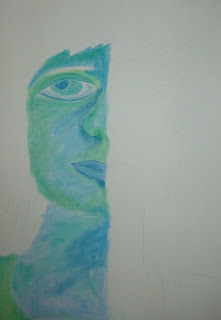Artist inspired group drawings and monoprints.
During my recent visit to MOMA in New York, I discovered a few amazing artists. Gert and Ewe Tobias's small monoprints in the printmaking exhibition inspired the following workshop in Fullerton House.
We began by looking at paintings by Gert and Ewe Tobias. The girls noticed the geometric shapes used to make up each imaginary character and their individual personalities. We made group drawings using the idea of the exquisite corpse. Each person got to draw a head, torso and legs before unveiling the strange characters.
Looking at artists examples for inspiration.
The final drawing unveiled!
We then placed acetate on top of the drawing and used it as guide to paint and monoprint onto yellow card.
Once the painting on acetate is complete, carefully press it onto coloured card and your monoprint is complete. We cut the characters out and placed them on a colourful, geometric background for display.
Henri Rousseau inspired jungle screenprints
The girls were intrigued by Rousseau's busy jungle paintings so we decided to create our own version. We spent one week screen printing tigers and overlapping firey colours to get interesting skin patterns.
The second week we used various tones of green and yellow to print leaves. (Plus some sneeky bright pink and blue!) We looked at the abundance of leaf shapes in Rousseau's paintings to help us. We used torn paper to create leaf shapes and layered some to make multi colour leaves.
Our finished artwork: A collage of busy, bright and vibrant jungle life.
And even better, Fullerton House are going to frame it and permanently hang it on the school walls for future generations to enjoy!
Favourite final artwork of 2012 so far!
Layered Butterfly Mobiles
Screen printing was such a success we decided to use it again. The girls first designed and cut out butterfly shapes from card. A library book of butterflies really helped our designs. We screen printed using a rainbow of colours, giving us wavy and unpredictable patterns. We also used mini doilies and perforated paper to create patterns.
We attached the butterflies together, added gems and fancy threads for decoration.
Drypoint: Cross Section Drawings
The pupils were very lucky to use a professional printmaking press borrowed from the Belfast Print Workshop.
First, the pupils made their cartoon drawings showing a cross section of the sea. They drew a man in a boat and everything underneath. One pupil drew an underwater gym!
They placed acetate on top and used a sharp point to scratch along the lines.
Once the lines were scratched on, they inked up the acetates and used scrim to rub away excess ink. The 'burr' created by the scratching will hold the ink. Now it's time to print!
We print onto damp paper, which I had soaking in a water bath.
The big reveal! You can see how the ink has transferred beautifully! The drypointed lines have a soft fuzzy quality.
So that's the printmaking club finished until next year!
Best of luck to the Primary 7's and their move to grammar school. Have a great summer!































































